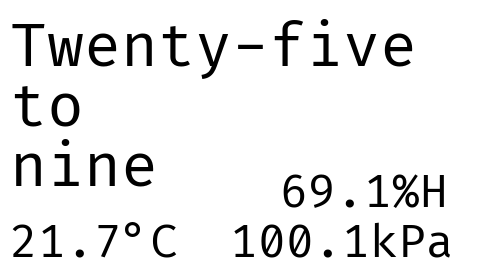Project: Making an E-Paper Clock
I made a clock for my flat out of an E-Paper display and a Raspberry Pi Zero W.
It displays the time, accurate to within 5 minutes, for example: "twenty-five to nine", and it also shows recent values of some environmental sensors around my flat.

Why would you do that?
I think it looks pretty cool, and it can be read from a good distance thanks to the font size and how crisp e-paper is. I like how the imprecise but accurate time makes you think about the time also, as in most cases knowing it down to the minute, or down to the second, isn't really necessary.
There are also the usual reasons, making something for myself is satisfying, and having complete control over how it works means that it can integrate well with the other things I've made, like my weather sensors.
The Hardware Design
This project was made out of things I had lying around that I'd bought
a while ago to try out without a particular use in mind. This explains
why I used an entire Raspberry Pi to tell the time, the e-paper display
I had was designed to connect to the Pi's
So the hardware design consisted of me plugging the Pi Zero W into the 4.2" Waveshare e-paper display hat, through its GPIO header.
The Software Design
Since development on the Pi zero can be annoying due to its low processing power leading to slow responses to commands, I decided to keep the Pi zero as a thin client that just displays an image when it's been told to. Then since I already have a speedy Pi 4 running a Python webserver with FastAPI, I could add the functionality for drawing the clock face image to that, and enjoy quickly trying out changes to the code on the Pi 4, which I'm already SSH-ing into and making changes on often enough. When making large changes, since the server is deployed in a docker container, I tend to make the changes on my PC and then send the changes to the Pi when it's finished.
Since I had an entire Pi dedicated to telling the time, there wasn't really any reason to be efficient with the software. The Pi zero runs a Python script that listens for MQTT messages from the Pi 4, and when it gets one telling it to update the display, it downloads the bitmap over HTTP from a known URL served by the Pi 4. It's maybe 75 lines or so of Python, and it hasn't needed changing in the year or so it's been running so far, just set and forget.
While that code itself stayed unchanged, I did find once or twice that it had stopped running for reasons unknown. Rather than figure out why, I just installed Supervisor and wrote it a configuration file to ensure the program gets restarted if it ever dies. Since then I've not noticed it stop working once. This was a lazy approach, but the clock is designed for a target audience of just me, and I've got plenty of things that are noticeably broken to fix, before I start fixing the things that aren't.
With the Pi zero acting as a thin client, all the server had to do was draw the time and some sensor readings onto a bitmap every now and again, and send it. The sensor readings are from a TimescaleDB database, which is an extension for Postgres that gives it compression for time-series data. The data was dutifully collected by my Python script from sensors around my flat over MQTT and piped into the database. The server runs a query to get the median value of each measurement over the past hour.
The time was generated in its fuzzy text format once every minute, and the image was updated if the time was different to the time of the last minute, so the display updated every five minutes. This is well suited to the nature of e-paper, since this display takes around 5 seconds to fully update. For a while, the time was stuck to UTC and wouldn't change for summer time, despite my Pi's system time updating. Eventually I figured out that the docker container has its own time zone, so once I'd set that, the clock went back and forth each year on its own.
Once all that was sorted, the system has been left running for a year and it seems to have kept running smoothly the whole time.

What Next?
There's no room left on the display to add extra info, so I'm currently looking at a larger display and a nice wooden picture frame to put it in. This could show the same info as the current clock, but with plenty of area for anything else underneath. It would be nice to have the power consumption measured by the smart sockets in my flat, and maybe my todo.txt file displayed as well to make it harder to forget/ignore.
As for the current e-paper clock, I'm quite happy with how usable, nice to look at, and reliable the project turned out to be, considering how it was mostly made in an afternoon if you don't count the bug-fixes. I'd recommend having a go to anyone with a spare ~£40 and a spare afternoon.